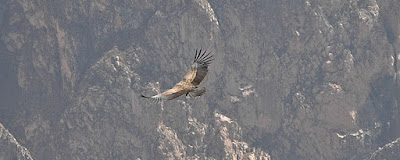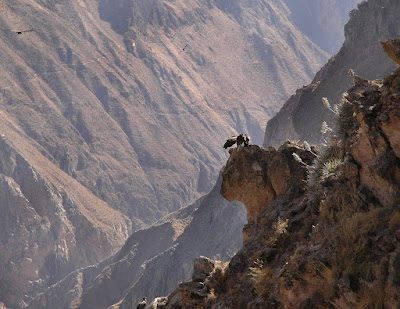- * Alpacas are the size of sheep, but with a little bit longer necks. The Spanish called them long-necked sheep. Our guide, Nancy, was standing next to me as we looked at once grazing near our feet, and she said, "Aren't they cute? And so delicious." It made me laugh out loud. I always thought alpacas were closer in size to vicunas, a little smaller than llamas. Nope.


- * People are mestizo, but they still hold hard feelings toward the Spanish for the brutality of the conquest. Our guide Nancy said she doesn't like to take Spanish tourists. Of course the feelings are complicated, because they have Spanish heritage, and their churches are primarily spanish colonial. Every year there is a festival where they catch a giant condor and make it fight a bull. The condor represents the indigenous people, and the bull represents the Spanish. If the condor wins, it will be a good year.
- * Arequipa is called the White City. The general story line is that this is due to the white volcanic stone that's used in most construction. Apparently, no. When the Spanish took over Arequipa, they ran all the natives out of town and made them live on the outskirts. So when people visited the city, all they saw were white people. So, white city. White people.
- * The pre-Incan people who lived in Colca Canyon were of two different groups. One group lived in the valley, the other lived in the canyon. But they were tied to the mountain they came from in a very deep way. So they deformed their infants' skulls to resemble the shapes of their mountains. One group put wood on top of the babies' heads so the skulls were squat and square. The other group put wood on the sides of the babies' heads so the skulls were long and thin. Each shape not only identified them from afar, it also tied them to their mountains. The Spanish put an end to skull deformation, so instead, the people adopted different hats -- a squat hat, and a tall hat. They still wear them.
- * The people in the canyons still farm the Incan terraces.
- * People in the canyons and valleys still operate on the barter system, with people from Cuzco. The people from Cuzco load up their llamas and WALK. It takes between 30 and 60 days. They trade food with the valley and canyon people, then they walk back. They still do this, every year.
- * There are more than 5,000 different species of potato in Peru.
 When we walked out of the hotel and saw our bus, Marc asked if it was just for us.....we couldn't believe it. It seemed crazy to have the whole thing just for us, plus a guide and a driver, but that's what we got.
When we walked out of the hotel and saw our bus, Marc asked if it was just for us.....we couldn't believe it. It seemed crazy to have the whole thing just for us, plus a guide and a driver, but that's what we got. So they picked us up yesterday morning at 8am and we took off for Chivay. We stopped along the way at all kinds of interesting places -- Incan cemetaries, amazing views, small towns with huge white churches.
So they picked us up yesterday morning at 8am and we took off for Chivay. We stopped along the way at all kinds of interesting places -- Incan cemetaries, amazing views, small towns with huge white churches.Incans believed in reincarnation, so they were buried fully clothed, with food and other stuff they'd need. Some were buried in these little caves, high on a cliff face. You may have to click the photo to see it full-sized to see the burial caves:

 The churches were usually white, with green or aqua doors. Often one or both bell towers had been knocked down in an earthquake, but they were always rebuilt as quickly as possible. In such poor villages, the churches were often magnificent:
The churches were usually white, with green or aqua doors. Often one or both bell towers had been knocked down in an earthquake, but they were always rebuilt as quickly as possible. In such poor villages, the churches were often magnificent:



 Chivay is a small town of 3,000 people, and the hotel we stayed in was charming but the rooms were spartan. Twin beds, no television or anything else, just a phone. And a wall heater, because it got cold there at night. But the grounds and individual cottages were adorable:
Chivay is a small town of 3,000 people, and the hotel we stayed in was charming but the rooms were spartan. Twin beds, no television or anything else, just a phone. And a wall heater, because it got cold there at night. But the grounds and individual cottages were adorable:We ate lunch in Chivay; I had quinoa soup, which was really delicious, and -- what else, here in Peru -- chicken.
We were really high, approximately 4,500 meters. For the first time, we really felt the altitude. We couldn't breathe, walking more than a few steps left us exhausted, we had headaches, and I was dizzy. Other people at the overlooks were dizzy too, prompting Marc to tell me that we were just a bunch of dizzy people stumbling around. It tickled me, and sounded like a blog post title.
This morning they picked us up at 6:30 for our ultimate destination, which was Cruz de la Condor. (or maybe de los Condors, I have to look) It was not certain that we'd see condors, of course. It's not the rainy season, and people yesterday didn't see any at all. Last week they waited three hours, no condors. When we walked to the edge, we saw three huge condors sitting on the rocks, in the sun. Just a couple of minutes later, two enormous condors flew up from our left and it seemed like they were showing off for us, gliding pretty near us, in large circles, riding the thermals. Then more condors pulled out, and more. At one point there were ten flying and sitting close by. It was truly amazing.





 Condors are scavenger birds, of course, and boy they're really ugly up close. Standard bald scavenger bird head, big hooked beak for tearing meat, a face only their mothers must love. But when they soar and glide, it is breathtaking. It was so beautiful it made me cry. They only have one egg every other year, and the baby stays in the nest until it's two years old. The females have red eyes, which is pretty creepy, and the males have black eyes. The male has a bigger crest on his head than the female. Otherwise they're nearly identical. Red eyes, pretty weird.
Condors are scavenger birds, of course, and boy they're really ugly up close. Standard bald scavenger bird head, big hooked beak for tearing meat, a face only their mothers must love. But when they soar and glide, it is breathtaking. It was so beautiful it made me cry. They only have one egg every other year, and the baby stays in the nest until it's two years old. The females have red eyes, which is pretty creepy, and the males have black eyes. The male has a bigger crest on his head than the female. Otherwise they're nearly identical. Red eyes, pretty weird.I'll organize this post a little later, for now I have to jot down everything I can think of. The people have domesticated llamas and alpacas, but vicunas and guanacos (which we didn't see) are wild. The corrals are low fences of stacked stones, which don't save them from pumas but do make it harder for the foxes (oh yeah, we saw a big fox, real pretty).

It was rare to go more than a couple of yards without seeing small stacks of stones. Occasionally it would be like a pyramid, but most often it was just a stack of six stones, more or less. There were places where the entire field was full of these little stone towers. In places where tourists gather, they make little stone towers, and lots of them. But in open areas, no people within site, the stone towers were there. It's a very rocky place, so if you have rocks, you do everything you can with them.
Around 90% of the country is catholic, but the rest still worship Mother Earth (Pachamama) or their own mountain.
The people who wear traditional dress have figured out that they themselves are what people want to see, that people want to take pictures of them. So they invite you to take pictures, for a few soles. It's not much money, but I never could figure out how I felt about it. On one hand, they make themselves a commodity. On the other hand, why shouldn't they, and it's an important form of income for them. We only did this once, so far:
 Women and kids gather their goats and llamas, put on their hats and outfits, and head to the square to target obvious tourists for photos. Only one or two soles:
Women and kids gather their goats and llamas, put on their hats and outfits, and head to the square to target obvious tourists for photos. Only one or two soles: Snacks -- the traditional Andean Twix bars, I guess.
Snacks -- the traditional Andean Twix bars, I guess. Dancers in Yanque put on a daily show for the tourists
Dancers in Yanque put on a daily show for the tourists
One small village, Maca, suffered a big earthquake in 1991 and 23 people were killed. You could see the enormous vertical fissures in the mountains. The mountain just split apart. I had such a profound feeling of being on a living planet.
Happy in Colca












2 comments:
Crikey you are havin' a good time!
Happy Birthday (belated), and give those people your money! I'm sure it's more dignified than other forms of bringing in some cash, in that they can provide a service, labour, et cetera. Not much different from what people do in highly-structured capitalist societies. Offer them residual rights on the photos you publish!
But mostly, have a good time, share in the joys of place and people.
Yes indeedy, it was an amazing good time. When I read "crikey" I laughed so hard. As I thought about the situation, I realized I am a commodity, I sell myself in Manhattan (well, I sell my time but really what's the difference) so it didn't bother me so much.
It was a wonderful, wonderful trip. Highly recommended.
Post a Comment